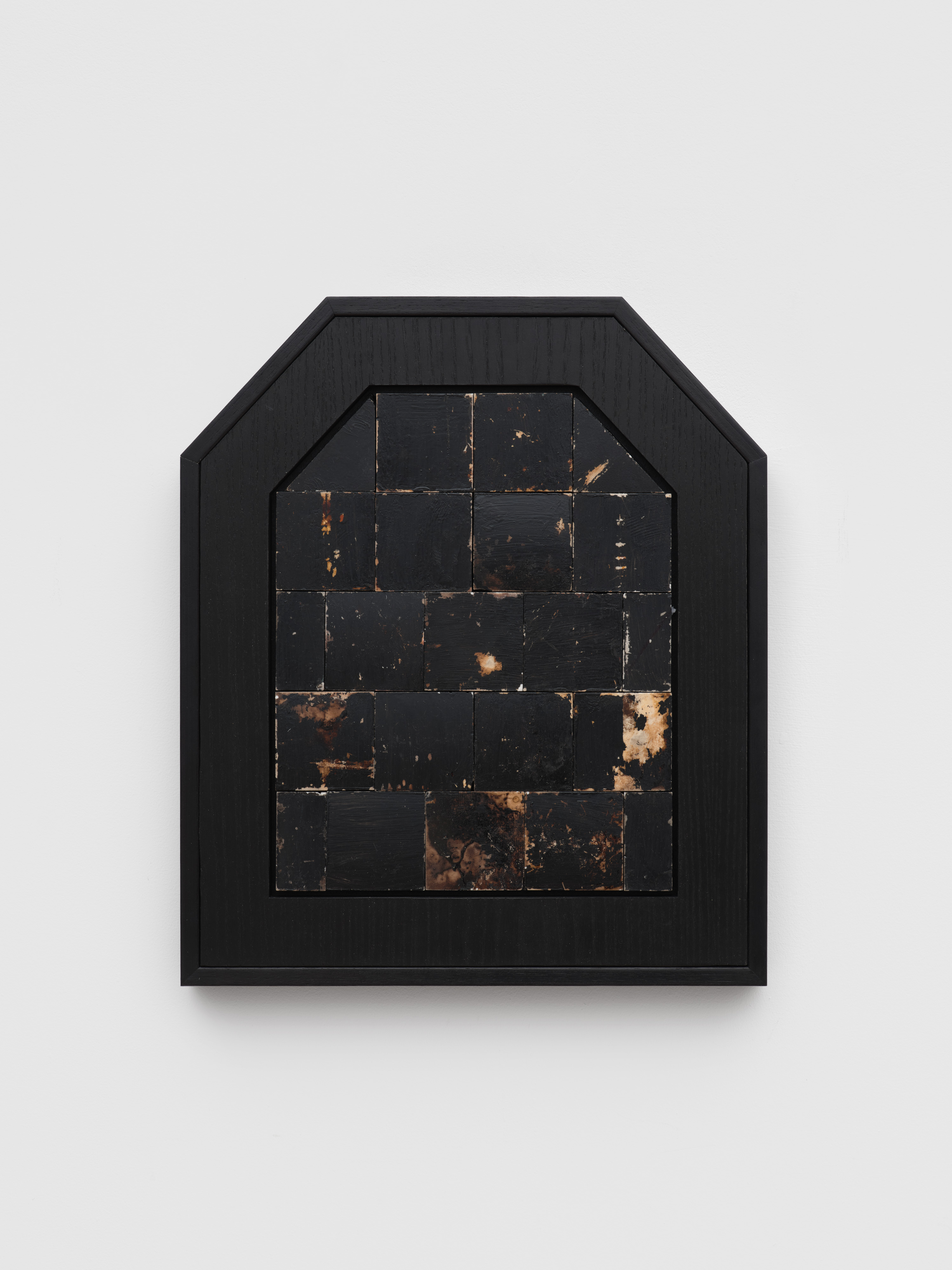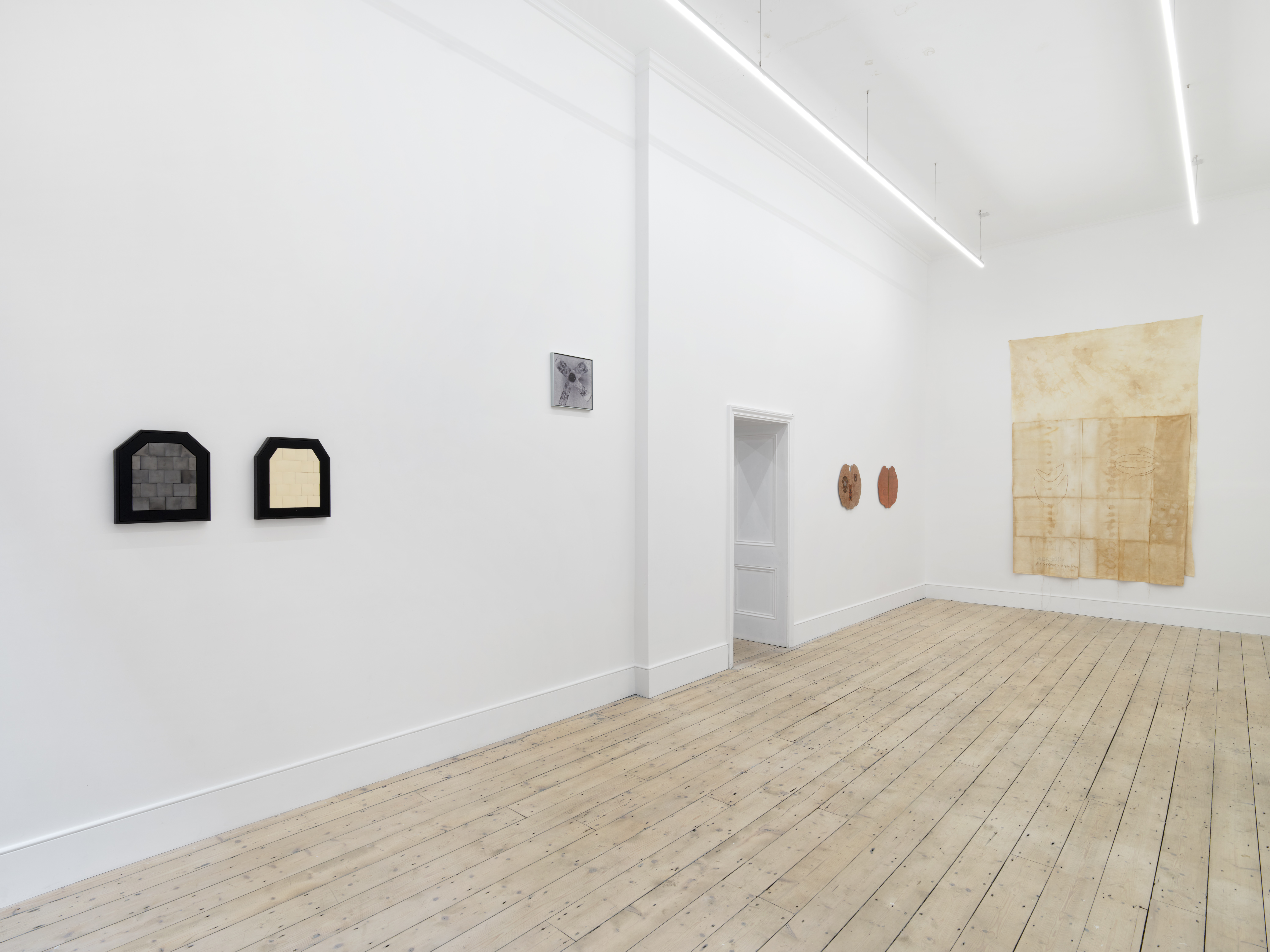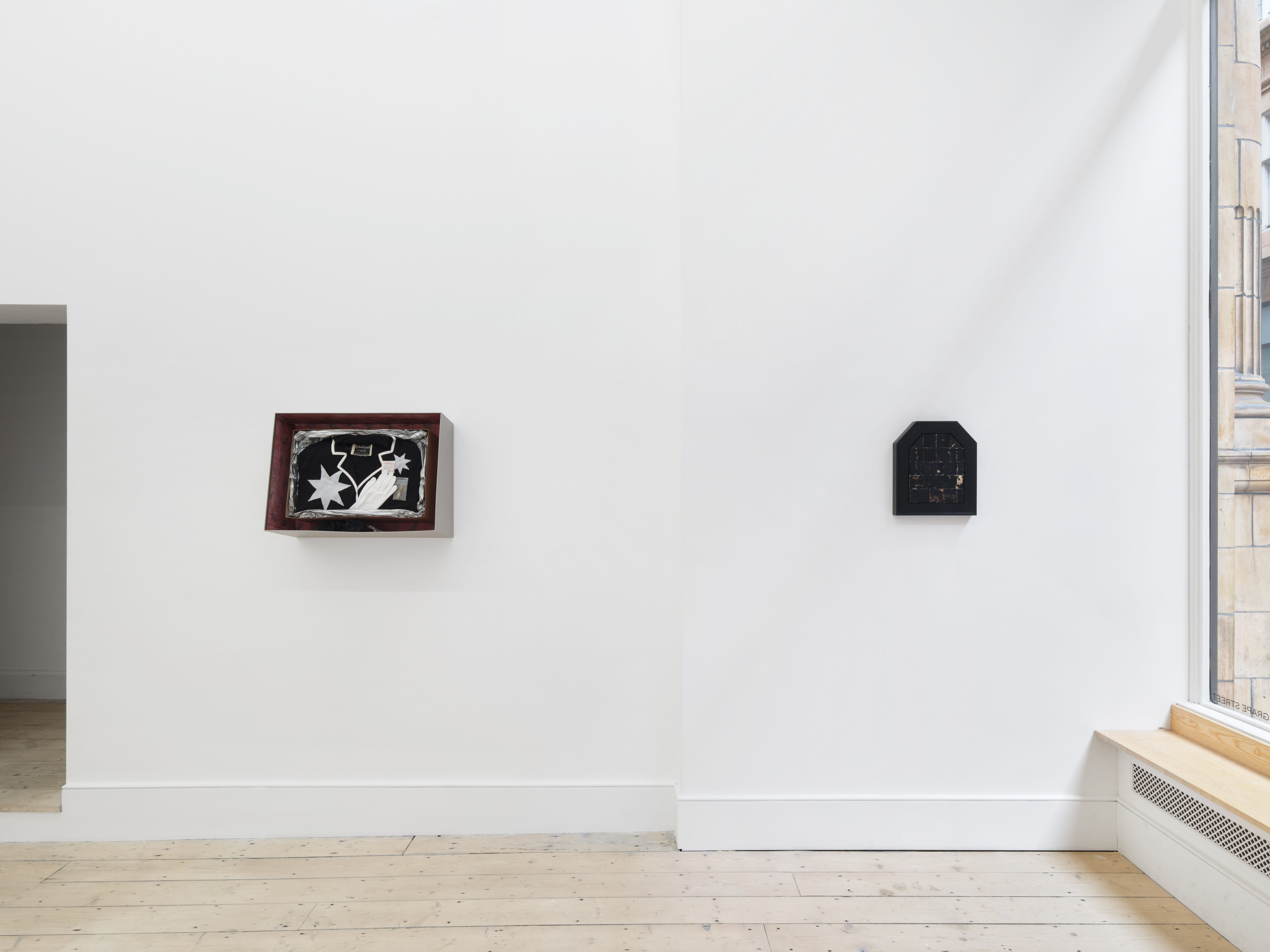“A garment, a pin, a seam, a shield”
Myriam Mihindou, Liz Magor, Joanna Piotrowska, Vivian Lynn, Gray Wielebinski
group show, Phillida Reid, London, UK
May 23 – July 27, 2025
![]() Tomb I, Tomb II, 2025
Tomb I, Tomb II, 2025
silicon carbide bulletproof tiles, acrylic paint, custom wood frame
34 x 29.5 x 4 cm each![]()
![]() Proof, 2025
Proof, 2025
silicon carbide bulletproof tiles, acrylic paint, custom wood frame
34 x 29.5 x 4 cm
![]() Cartridge, 2025
Cartridge, 2025
inkjet print on silicon carbide bulletproof tiles, aluminium
31 x 31 cm![]()
Myriam Mihindou, Liz Magor, Joanna Piotrowska, Vivian Lynn, Gray Wielebinski
group show, Phillida Reid, London, UK
May 23 – July 27, 2025
 Tomb I, Tomb II, 2025
Tomb I, Tomb II, 2025silicon carbide bulletproof tiles, acrylic paint, custom wood frame
34 x 29.5 x 4 cm each

 Proof, 2025
Proof, 2025silicon carbide bulletproof tiles, acrylic paint, custom wood frame
34 x 29.5 x 4 cm
 Cartridge, 2025
Cartridge, 2025inkjet print on silicon carbide bulletproof tiles, aluminium
31 x 31 cm

A garment, a pin, a seam, a shield is an exhibition of work by Myriam Mihindou, Liz Magor, Joanna Piotrowska, Vivian Lynn, and Gray Wielebinski. Across collage, textile, photography, sculpture and film, the exhibition looks at ways in which the body – and its coverings – become sites of tension, care, rupture, and remediation.
Myriam Mihindou’s practice is concerned with repair and resilience, the marks imposed upon the body by trauma and systems of control. Folle (2000), a video projected onto the floor of the gallery, sees the artist’s feet from a first-person perspective, negotiating a wide white crack between two paving stones, a crossing soundtracked by a persistent chorus of laughter. In the 2018 video work La robe envolée, a static shot frames the artist’s legs as she methodically pulls, tears and rips at layered pairs of tights, as if forcibly shedding a skin – an act that feels at once cathartic and violent. Mihindou’s 1999 – 2000 photographic series Sculptures de chair (‘flesh sculptures’) document a ‘ritualised creative process’ in which she would paint, bind, mark, and pierce her hands with silver pins (in these cases, the hand under attack becomes a sharp claw).
Pins reappear in Mihindou’s series Le Patron (2022 – 2024), in which fragile, skin-like leaves of paper and silk are layered, tacked, and stitched together. Soaked repeatedly in tea (a material favoured by Mihindou for its association with healing and therapeutic ritual) and ink, the compositions are inscribed with hand-written and sculpted text in graphite and twisted copper wire. They speak a halting language, incorporating fragments of French and Latin, veer between lyrical, incantatory and bureaucratic.
Joanna Piotrowska’s Untitled (2024) is a collage of silver gelatin hand prints set in a ditsy print cloth-covered frame, cinched tight on one edge with a steel ring that pierces through the glass and image surface. The enclosed image, overlaid with a small fragment cut from a larger print, hones in on a section of torso enveloped in a loosely draped t-shirt, fabric gathering under a hand firmly clasped around the wearer’s waist – a gesture of affection, protection, or perhaps, constraint.
A series of garment collages by Liz Magor from the series Being This (2012/2022) consist of thrifted clothes, folded lovingly into gift boxes lined with pillowy tissue paper. These compositions, accessorised with transposed and reversed labels, insignia, sales tags, and scraps, become proxy for the body and its accumulations, as dainty gloves point toward a moment of interest, or mimic a hand raised in a gesture of courtesy or defence. Pocketed wrappers, papers, and cigarette butts of anonymous provenance are tucked into the box margins like footnotes.
In 2018’s Open and Closed, two well-worn woollen blankets, purchased from second-hand stores, hang like shrugged coats, each wrapped in clear film similar to that of dry cleaners’ plastic garment bags. The works are derived from a series in which Magor uses dyes and embellishments to enhance and preserve the stains, singes, and frays accrued throughout the textiles’ years of service, before dry cleaning and re-presenting them. They are riddled with moth-holes and burns that are carefully filled and darned (Closed) or haloed in red so that they radiate outwards (Open), resembling hides scattered with wounds, blemishes, or bullet holes.
New works by Gray Wielebinski (2025) are formed of mosaic-like panels of monochromatic tiles mounted in custom shaped frames evocative of houses, headstones, or vests. Wielebinski’s tiles are, in fact, bulletproof ceramic body armour, so shaped to cover and defend a human torso. Extracted from the fabric covers within which they would normally be concealed, and from their intended context of gun culture (and attendantly, law enforcement, military gear and violence), the panels exist as exposed alienated material, encoded with implications of bodily protection, shelter and self defence.
Taking the shape of Rorschach ink blots reminiscent of shields or shells, Vivian Lynn’s Mind Field series (2007) embodies Lynn’s conception of a mutable, permeable selfhood in constant interrelation with its surroundings. One of the last bodies of work produced in her lifetime, the series insists beyond internal-external binaries as they relate to the material, permeable existence of the world around us. “A corporeal, visceral, neural, erotic mind self in the world,” as she elaborated in a 2007 interview, “where identity emerges, ebbs, flows and mutates from behaviour in the lived space we inhabit. No awful inner self but an epidermal self, where as Sappho said, ‘a subtle fire has stolen beneath my flesh’.”
The skin, here, becomes the seat of the self; a porous meeting place of body, mind and environment, its fragility hinted at in Lynn’s use of wrinkled, glue soaked gampi paper sheets that are just sheer enough to disclose the metallic aluminium surface beneath. In Mind field: a hair strand contemplates the order X, the composition appears to split open at its centre as if stretched too tight, revealing a fine, subcutaneous seam of gold.
Bringing together works that linger on the body not solely as image but as evidence and residue, A garment, a pin, a seam, a shield explores how these charged surfaces can absorb and carry histories, often unspoken or withheld. What emerges is a shared language of puncture, tension, and repair across the body: a pin pressed into flesh, a seam undone and remade, a blanket wounded and sutured, or an armour that mourns its own violence. The body appears refracted, displaced, and made into something we read through materials: heavy with meaning, soft with memory, precariously held together.
![]()
![]()
![]()
Myriam Mihindou’s practice is concerned with repair and resilience, the marks imposed upon the body by trauma and systems of control. Folle (2000), a video projected onto the floor of the gallery, sees the artist’s feet from a first-person perspective, negotiating a wide white crack between two paving stones, a crossing soundtracked by a persistent chorus of laughter. In the 2018 video work La robe envolée, a static shot frames the artist’s legs as she methodically pulls, tears and rips at layered pairs of tights, as if forcibly shedding a skin – an act that feels at once cathartic and violent. Mihindou’s 1999 – 2000 photographic series Sculptures de chair (‘flesh sculptures’) document a ‘ritualised creative process’ in which she would paint, bind, mark, and pierce her hands with silver pins (in these cases, the hand under attack becomes a sharp claw).
Pins reappear in Mihindou’s series Le Patron (2022 – 2024), in which fragile, skin-like leaves of paper and silk are layered, tacked, and stitched together. Soaked repeatedly in tea (a material favoured by Mihindou for its association with healing and therapeutic ritual) and ink, the compositions are inscribed with hand-written and sculpted text in graphite and twisted copper wire. They speak a halting language, incorporating fragments of French and Latin, veer between lyrical, incantatory and bureaucratic.
Joanna Piotrowska’s Untitled (2024) is a collage of silver gelatin hand prints set in a ditsy print cloth-covered frame, cinched tight on one edge with a steel ring that pierces through the glass and image surface. The enclosed image, overlaid with a small fragment cut from a larger print, hones in on a section of torso enveloped in a loosely draped t-shirt, fabric gathering under a hand firmly clasped around the wearer’s waist – a gesture of affection, protection, or perhaps, constraint.
A series of garment collages by Liz Magor from the series Being This (2012/2022) consist of thrifted clothes, folded lovingly into gift boxes lined with pillowy tissue paper. These compositions, accessorised with transposed and reversed labels, insignia, sales tags, and scraps, become proxy for the body and its accumulations, as dainty gloves point toward a moment of interest, or mimic a hand raised in a gesture of courtesy or defence. Pocketed wrappers, papers, and cigarette butts of anonymous provenance are tucked into the box margins like footnotes.
In 2018’s Open and Closed, two well-worn woollen blankets, purchased from second-hand stores, hang like shrugged coats, each wrapped in clear film similar to that of dry cleaners’ plastic garment bags. The works are derived from a series in which Magor uses dyes and embellishments to enhance and preserve the stains, singes, and frays accrued throughout the textiles’ years of service, before dry cleaning and re-presenting them. They are riddled with moth-holes and burns that are carefully filled and darned (Closed) or haloed in red so that they radiate outwards (Open), resembling hides scattered with wounds, blemishes, or bullet holes.
New works by Gray Wielebinski (2025) are formed of mosaic-like panels of monochromatic tiles mounted in custom shaped frames evocative of houses, headstones, or vests. Wielebinski’s tiles are, in fact, bulletproof ceramic body armour, so shaped to cover and defend a human torso. Extracted from the fabric covers within which they would normally be concealed, and from their intended context of gun culture (and attendantly, law enforcement, military gear and violence), the panels exist as exposed alienated material, encoded with implications of bodily protection, shelter and self defence.
Taking the shape of Rorschach ink blots reminiscent of shields or shells, Vivian Lynn’s Mind Field series (2007) embodies Lynn’s conception of a mutable, permeable selfhood in constant interrelation with its surroundings. One of the last bodies of work produced in her lifetime, the series insists beyond internal-external binaries as they relate to the material, permeable existence of the world around us. “A corporeal, visceral, neural, erotic mind self in the world,” as she elaborated in a 2007 interview, “where identity emerges, ebbs, flows and mutates from behaviour in the lived space we inhabit. No awful inner self but an epidermal self, where as Sappho said, ‘a subtle fire has stolen beneath my flesh’.”
The skin, here, becomes the seat of the self; a porous meeting place of body, mind and environment, its fragility hinted at in Lynn’s use of wrinkled, glue soaked gampi paper sheets that are just sheer enough to disclose the metallic aluminium surface beneath. In Mind field: a hair strand contemplates the order X, the composition appears to split open at its centre as if stretched too tight, revealing a fine, subcutaneous seam of gold.
Bringing together works that linger on the body not solely as image but as evidence and residue, A garment, a pin, a seam, a shield explores how these charged surfaces can absorb and carry histories, often unspoken or withheld. What emerges is a shared language of puncture, tension, and repair across the body: a pin pressed into flesh, a seam undone and remade, a blanket wounded and sutured, or an armour that mourns its own violence. The body appears refracted, displaced, and made into something we read through materials: heavy with meaning, soft with memory, precariously held together.


